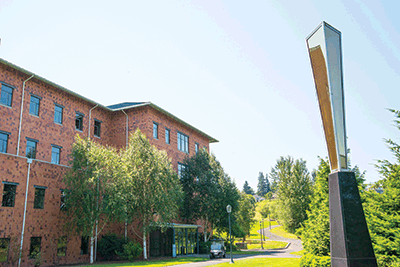It is a common reaction to economic downturn: companies understandably tighten their budgets; non-essential or slow-to-return investments get nixed pretty quickly. During the Great Recession, this was the case not only in Southwest Washington, but throughout much of the nation, as investing in a company’s most valuable asset – their employees – fell victim to the reigning in of purse strings.
With signs that economic recovery is turning the tide, investing in workforce development is gaining momentum, and the return on investment in this realm appears more sound than ever.
Kevin Witte, Clark College’s associate vice president of corporate and continuing education, shared his insight into why developmental retreat happens.
“It is natural during a recession or economic slowdown for companies to be wary of spending,” he said. “Businesses go into survival mode.”
Another factor, Witte noted, was that during the Great Recession, “Baby Boomers who would otherwise attrition into retirement either stayed or came back to employment.” As a result, many employers enjoyed an already fully-trained workforce, shifting the focus to retaining talent as opposed to developing it.
However, the recession did have a positive impact for some in workforce development, according to Witte.
“Some used education as a tool to reform or reinvent themselves during this time,” he said, pointing to areas of lean manufacturing and efficient business/staffing practices as drivers of expanded learning.
Return on investment
While the improving economy may have businesses in a better financial position to offer workforce development training, other challenges are constant.
“In our outreach, it seems that employers are very interested in providing training for their current workforce,” said Tim Foley, director of employment and training for the Southwest Washington Workforce Development Council (SWWDC), which has a pair of grants that include funding for incumbent worker training. “For manufacturers running at capacity, finding the time to make their workforce available for training is a challenge.”
Theresa Wagner, chief external affairs officer at the Port of Vancouver, agreed that it can be difficult to tear away from day-to-day operations, but said it can be well worth it. In the port’s case, she said, making the training relevant is vital.
“Staff is our most valuable asset,” said Wagner. “Investing in them delivers benefit now and in the long-run.”
Partnering with Washington State University Vancouver, the port created a major leadership development project, personalized to the port’s needs. Wagner said she saw a ten-fold return on the $48,300 investment.
“The training has used real examples and case studies from the challenges that we are directly working through,” she explained. “This has helped us yield immediate impact from the personnel that participated in the program.”
By taking workforce training to the construction industry, Skanska USA Building Inc. has also seen a sizable return on investment. In 2011, the company created the BOOST program (Building with an Objective to provide Opportunity through Sustainable Training) – a 10-week series of two-hour classes offered to minority and emerging small construction companies.
Developed by Skanska’s Northwest Diversity Manager Mel Jones, the courses teaches sub-contractors how to put their best foot forward in bidding with general contractors, such as Skanska. Valued at $1,000 per participant, the company hosts the program for free.
“You don’t want to hope a sub-contractor or employee meets your expectations. Make sure they’re there or get them there,” Jones said.
Since the first class was held, more than 60 different small businesses have graduated from the program. 77 percent of those have gone on to work on Skanska projects.
Efficiency rules
Sometimes, as Lacamas Medical Group discovered, personnel development can come entirely from within. After discovering that its EMR (Electronic Medical Records) platform was only utilizing a small percentage of its capabilities, the company trained an existing employee to teach others throughout the organization how to use it more effectively and efficiently.
“Taking the time to observe, identify and train our staff on gaps in using the software that we didn’t even know were there paid huge dividends,” admitted founder Scott Jonason.
Lacamas Medical Group’s training has been so successful, Jonason noted, that other clinics have looked to the company for help in training their employees.
“If training yields a 5 percent increase in employee efficiency, what does that mean to your bottom line? Training is tremendously valuable,” Witte concluded. “To gain the most value from a training program you must ensure that whatever is learned is integrated and reinforced into the business model.”
Future investments
Historically, it has been difficult for workforce development organizations to secure grants that include funds for incumbent worker training. However, with President Obama’s upcoming re-authorization of the Workforce Investment Act (scheduled to go into effect next year), Foley said the SWWDC is hopeful that it will have more funds to assist local companies with training.
“So far, it looks like we will have the opportunity to spend more of our foundational money on incumbent training,” he said. “Possibly up to 20 percent more.”




